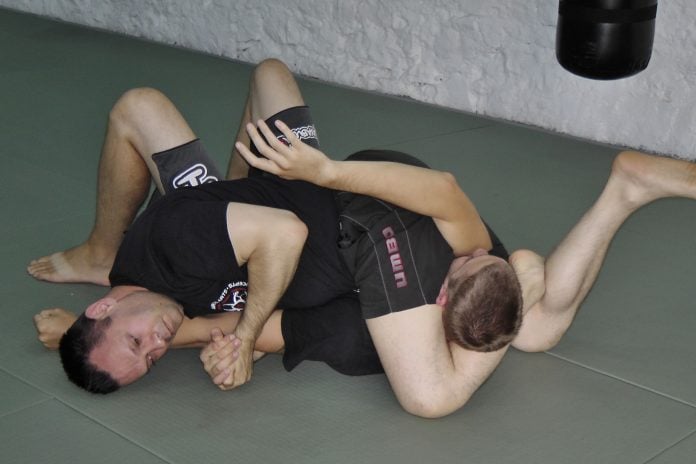
When we’re talking submissions in Brazilian Jiu-Jitsu we either think chokes or joint locks. If you take the modern leg locking craze aside, you’re left with good old arm locking options. In terms of armlocks, people tend to go for one of two choices. They either hit a straight arm submission or a bent arm variation. While the bent arm variations boast with plenty of variety, as far as straight arm submissions are involved, there’s only one – the armbar. However, the armbar has a next door neighbor that’s just as potent if not more. The straight armlock is old school submission straight out of hell, for those that know how to use it.
Ah, we’re on to explore the world of a true BJJ classic once again. The straight armlock is as old school as submissions get. It even features as far back as the very first “self-defense” instructional. In BJJ, the approach to the straight armlock is different – it works. There’s no apparent reason why people avoid this easy and effective submission hold nowadays. The straight armlock is available from a variety of positions, both from top and bottom. Furthermore, this move works just as good with the GI as it does in No-Gi. Let’s revisit this forgotten submission and see where it can feature in a modern grappling game plan.
As the trend of submissions changes over the years, some moves get left behind very often. IT happened to leg locks until a while ago. It happened to a host of sneaky moves that work like a charm if you’re aware of their existence. The straight armlock is not one that was completely forgotten, however, it is one that most people skip over when they roll. That’s a real shame since it presents itself during transitions between other submissions and positions of control. Why skip over a legitimate and easy to master submission hold, just because you’re not sued for hunting it?
The Secret Of The Straight Armlock
The straight armlock works much like the armbar. The ultimate aim is to place pressure behind the opponent’s elbow, on the side of the upper arm. The direction of the pressure needs to be opposite of the direction in which the elbow bends naturally. The main difference to that of the armbar is that you’re not using your hips to put pressure on the elbow. At least not directly.
The straight armlock is done with your body in, essentially, an opposite position than that of an armbar. The main source of pressure for the arm lock are the hands of both your arms. The grip to go for is the palm to palm grip, right above the ulnar process of the elbow. There’s a small little pocket there in which a palm to palm grip fits perfectly. Finishing the armlock requires leverage on the other side of the lever as well. This means you need to have something propped against the wrist of the opponent, pushing in the opposite direction of the pressure on the elbow. The best body part to use for this is your shoulder.
Finally, in order to make sure you truly have the armlock, you’ll need to trap their wrist in place. There’s no way to keep their arm on your shoulder just by placing it there. However, if you use your head, bending it towards the arm, there’ll be absolutely no way out. Keep in mind that this is the most usual way of setting up the straight armlock. There are ways to set it up that do not involve your shoulder or a palm to palm grip. But, more on that later.
Straight Armlocks From The Top
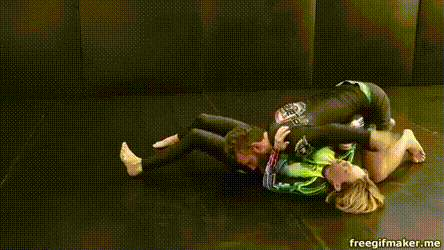
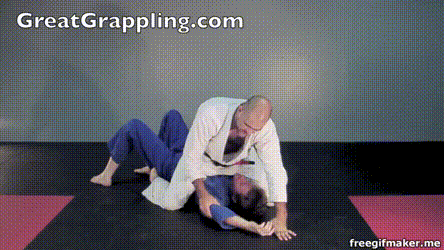
Bottom Armlock Set Ups
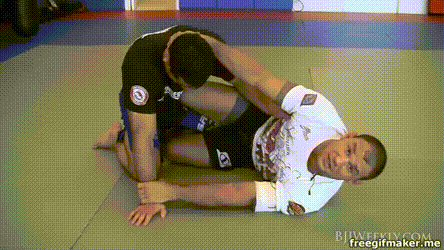
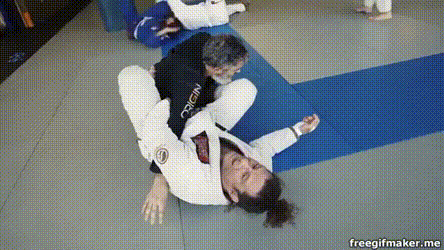
Check out what Chris Haueter has to say on the subject of straight armlocks. Even better, check out his complete “Old School Efficient BJJ: DVD instructional for a whole bunch of easy, effective and brutal movers most people have forgotten about!


![Darce Choke Encyclopedia – Origins, Mechanics and Variations [2025] BJJ, choke, Brabo, BJJ Darce Choke, D'arce Choke, Darce BJJ Choke](https://bjj-world.com/wp-content/uploads/2017/11/JungPoirierLeeYahoo-218x150.jpg)









![No-Gi Grapplers Guide To Front Headlock Joel Bane DVD Review [2025] No-Gi Grapplers Guide To Front Headlock Joel Bane DVD Review](https://bjj-world.com/wp-content/uploads/2025/03/no-gi-front-headlock-joel-bane-dvd-review-218x150.png)

![Get Off My Legs Gringo Craig Jones DVD Review [2025] Get Off My Legs Gringo Craig Jones DVD Review](https://bjj-world.com/wp-content/uploads/2025/03/get-off-my-legs-gringo-craig-jones-dvd-review-218x150.png)

![Leg Lock Entries Helena Crevar DVD Review [2025] Leg Lock Entries Helena Crevar DVD Review](https://bjj-world.com/wp-content/uploads/2025/03/leg-lock-entries-helena-crevar-dvd-review-218x150.png)
![Special K Guard Neil Melanson DVD Review [2025] Special K Guard Neil Melanson DVD Review](https://bjj-world.com/wp-content/uploads/2025/03/special-k-guard-neil-melanson-dvd-review-218x150.png)
![Collar Sleeve Guard Mikey Musumeci DVD Review [2024] Collar Sleeve Guard Mikey Musumeci DVD Review](https://bjj-world.com/wp-content/uploads/2024/12/collar-sleeve-guard-mikey-musumeci-dvd-review-324x235.png)
![Grappling Takedown Dominance Brandon Ruiz DVD Review [2025] Grappling Takedown Dominance Brandon Ruiz DVD Review](https://bjj-world.com/wp-content/uploads/2025/01/grappling-takedown-dominance-brandon-ruiz-dvd-review-100x70.png)
![How To Knee Cut Junny Ocasio BJJ DVD Review [2025] How To Knee Cut Junny Ocasio BJJ DVD Review](https://bjj-world.com/wp-content/uploads/2025/02/how-to-knee-cut-junny-ocasio-bjj-dvd-review-100x70.png)

![Closed Guard Reintroduced Adam Wardzinski DVD Review [2025] Closed Guard Reintroduced Adam Wardzinski DVD Review](https://bjj-world.com/wp-content/uploads/2025/01/closed-guard-reintroduced-adam-wardzinski-dvd-review-100x70.png)

![Simplify the System Side Scissor Brian Glick DVD Review [2024] Simplify the System Side Scissor Brian Glick DVD Review](https://bjj-world.com/wp-content/uploads/2024/09/side-scissor-brian-glick-dvd-review-2024-100x70.png)




![Special K Guard Neil Melanson DVD Review [2025] Special K Guard Neil Melanson DVD Review](https://bjj-world.com/wp-content/uploads/2025/03/special-k-guard-neil-melanson-dvd-review-100x70.png)
![Back Hacks Yigit Haney BJJ DVD Review [2025] Back Hacks Yigit Haney BJJ DVD Review](https://bjj-world.com/wp-content/uploads/2024/12/back-hacks-yigit-haney-bjj-dvd-review-100x70.png)
![Total Domination Top Control Mariusz Domasat DVD Review [2024] Total Domination Top Control Mariusz Domasat DVD Review](https://bjj-world.com/wp-content/uploads/2024/09/domination-top-control-mariusz-domasat-dvd-review-100x70.png)

![Advanced Immortal Clinch Matt Brown DVD Review [2024] Advanced Immortal Clinch Matt Brown DVD Review](https://bjj-world.com/wp-content/uploads/2024/09/advanced-immortal-clinch-matt-brown-dvd-review-100x70.png)
![Trip Throw Dilemma Michael Pixley and Heath Pedigo DVD Review [2024] Trip Throw Dilemma Michael Pixley and Heath Pedigo DVD Review](https://bjj-world.com/wp-content/uploads/2024/10/trip-throw-dilemma-michael-pixley-dvd-review-100x70.png)
![Back Control and Submission Felipe Pena DVD Reveiw [2025] Back Control and Submission Felipe Pena DVD Reveiw](https://bjj-world.com/wp-content/uploads/2025/01/back-control-and-submission-felipe-pena-dvd-reveiw-100x70.png)
![Upper Body Chain Attacks Janine Mocaiber DVD Review [2025] Upper Body Chain Attacks Janine Mocaiber DVD Review](https://bjj-world.com/wp-content/uploads/2025/03/upper-body-chain-attacks-janine-mocaiber-dvd-review-100x70.png)



![BJJ Foundations Mikey Musumeci DVD Bundle Review [2024] BJJ Foundations Mikey Musumeci DVD Bundle Review](https://bjj-world.com/wp-content/uploads/2024/09/bjj-foundations-mikey-musumeci-dvd-bundle-review-100x70.png)
![No-Gi Pressure Mastery JT Torres DVD Review [2024] No-Gi Pressure Mastery JT Torres DVD Review](https://bjj-world.com/wp-content/uploads/2024/10/no-gi-pressure-mastery-jt-torres-dvd-review-100x70.png)
![EMU Guard 2.0 Benjamin Power DVD Review [2024] EMU Guard 2.0 Benjamin Power DVD Review](https://bjj-world.com/wp-content/uploads/2024/11/emu-guard-2-0-benjamin-power-dvd-review-100x70.png)

![Slip N Slide Into Victory Julián Espinosa DVD Review [2025] Slip N Slide Into Victory Julián Espinosa DVD Review](https://bjj-world.com/wp-content/uploads/2025/01/slip-n-slide-into-victory-julian-espinosa-dvd-review-100x70.png)
![Master The Move Anaconda Strangle John Danaher DVD Review [2025] Master The Move Anaconda Strangle John Danaher DVD Review](https://bjj-world.com/wp-content/uploads/2025/02/anaconda-strangle-john-danaher-dvd-review-100x70.png)
![Top Half Guard Neil Melanson DVD Review [2025] Top Half Guard Neil Melanson DVD Review](https://bjj-world.com/wp-content/uploads/2025/02/top-half-guard-neil-melanson-dvd-review-100x70.png)